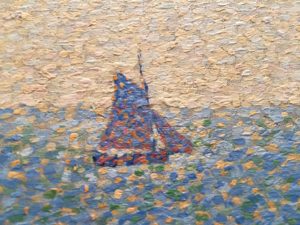Ever since I was a young girl one of my favorite places to visit has been the impressionist gallery at Boston’s Museum of Fine Arts. I was always particularly mesmerized by Monet’s Water Lilies series, and more than once I can remember sitting before one of his green, purple and blue canvases, and sitting and sitting and sitting. Along with the beauty that sprung from Monet’s mind and brush were the masters of pointillism, Paul Signac being a particular favorite of mine.
Both the idea of pointillism, the whole being so much more than the sum of its parts, and its woven intricacy fascinate me. So perhaps it shouldn’t surprise me that last Saturday when I stood before Signac’s Cassis. Cap Lombard, Opus 209 it occurred to me that I see my work with divorcing clients in much the same way.
Families systems are so much bigger than any individual’s particular apprehensions; if we fail to see our clients in the larger context of their lives, we fail them. The boat below if almost insignificant in the context of the larger painting while up close it appears to be the only object of significance. And the dots alone have no context until together they become the boat, the sea, the beach, the mountains – the entire of a small fishing village on the coast of southern France.

However, if we don’t see our clients as individuals we also fail them. In order for individual’s to thrive, their unique needs must be recognized. Although systems, legal and otherwise, often appear to be scientific or formulaic, they are often as much art as they are science. Without attending to the integration between what are often competing individual needs and the entire family system, grown-ups and children alike can become lost and untethered.
It was 130 years ago that Paul Signac wrote a manifesto in which he recommended looking at Neo Impressionist paintings as one would listen to an orchestra, saying:
To listen to a symphony, one doesn’t situate oneself among the brass but in a place where the sounds of the diverse instruments blend in the way the composer wanted them to. After that one could enjoy dissecting the score, note by note, and in doing so study the manner of its orchestration. In the same way, in front of a divided picture, it will be advisable first to stand far enough away to perceive the impression of the whole, then stop and come close to study the play of colored elements.
And so it is with individuals and families.


